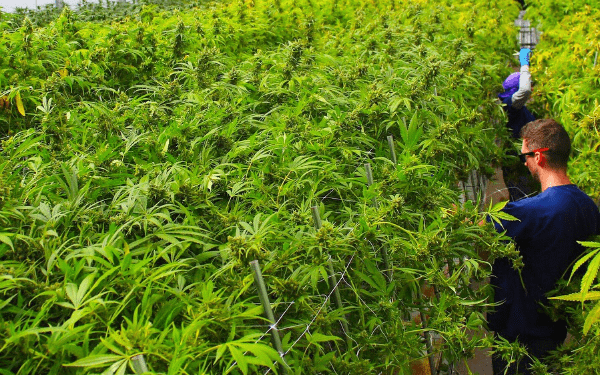States with nascent cannabis legalization often succumb to kinks in the master plan, like those seen in California, where samples have failed contamination testing or for improper labeling and packaging with the adoption of new regulations, prices have increased due to high taxation and increased demand, further fueling black market endeavors, and products without proper warning symbols will need to be destroyed. In Pennsylvania, the cannabis industry is progressively growing, with nearly 131,000 registered medical cannabis patients, and the creation of nearly 4,000 new jobs.

Website photo shoot
That is not to say that Pennsylvania has refined their industry to perfection; rather, the operation of the industry, to date, has differed from other markets, whether from having the foresight to require terpene testing and product labeling of terpenes and minor cannabinoids, or from being the first state to permit those people addicted to opioids to utilize medical cannabis instead. No one can stop and smell the flowers in PA dispensaries. We don’t have budtenders; we have “patient care specialists”. We don’t have edibles, or hash, or live rosin, yet. Dispensaries are not allowed to market certain products with colloquial terms like “moon rocks”. And an eighth of flower can cost upwards of $60. So, yeah, this market is different.
One thing that has been apparent from the start of the industry has been the focus on the medical aspects of the products. Sure, all of that sometimes glorious, but more often frustrating marketing jargon pervades many menus. If you browse through 33 cultivar names with similar THCA percentages, and simultaneously cannot inhale the exquisite differences between each plant, how do you make your selection? Some companies have sought to develop more novel cannabinoid and terpene formulations, products designed with specific outcomes in mind.

Website photo shoot
I had the opportunity to chat with Lisa Gray, Co-Founder and Vice Chair at Ilera Healthcare. Ilera has been marketing these types of formulations from the beginning days of the industry. They have a product called “Dream”, formulated to promote restful sleep, which contains an 8:1 THC to CBD ratio, and includes the terpenes/terpenoids phytol, myrcene, and the magnificent nerolidol. Another product is called “Breathe”, and is a 2:1 ratio of THC to CBD, with linalool and terpinolene added. This product is formulated to provide a sense of tranquility and decreased anxiety. A third product, “Hope”, has two different formulation options, with differing THC:CBD ratios, and terpene/terpenoid additions.

Website photo shoot
As you’ll well interpret, these products have meaning. The product name conveys the intended physiological outcome. And so, I was eager to learn more about the objectives of Ilera Healthcare in Pennsylvania.
T&T: What makes the cannabis industry in Pennsylvania different from other states, not only from a regulatory perspective, but also from a product design perspective?
Pennsylvania has strived to be a gold standard in the industry, with the team managing expectations and meeting timelines as planned. Open communication and transparency is always optimal. In terms of product design, Pennsylvania has 21 approved medical conditions for which patients can obtain a medical card. Our team has been working in our laboratory to develop formulations with partners and physicians who have specific insights as to formulation effectiveness that we feel specifically address some of these conditions. We have developed six of these formulations to date and have received very positive responses from consumers. Our goal is to pursue clinical validation for our formulated products. We’ll continue conducting patient outcome studies and trials to better understand the effectiveness of these medications.
T&T: What types of products have you found consumers tend to migrate to? High potency or a well-rounded blend? Flower or concentrate?
Our consumers purchase about 60% flower. We have over 300 varieties that we cycle through the growing process in our facility. We like to offer a well-rounded swath of flower options so we can advise on a product that best addresses our patients’ specific needs. About 20% of consumers like the cycling cultivars Ilera offers in our CHOICE line, which are oil-based vaporizable cartridges made from specific cultivars, that are free of residual solvents and cutting agents, and contain 75-90% total cannabinoids and “full-spectrum” terpenes extracted from the plants. The balance of 20% of patients prefer our indication-aligned formulated medicines, with a strong preference to our tinctures. Patients can drop the appropriate dose of extracted oil under their tongue or in a beverage, based on our dosage-indicated dropper as advised in discussions with our pharmacist. In many cases, patients also like to apply one of our topical creams along with the tincture.
T&T: Many of your products are specifically formulated to achieve an intended result. How are these tested to determine whether they will provide the intending effects?
The anecdotal (empirical experience) insights we have gathered to-date from patients have been positive as evidenced by their repeated use of these products. Ilera currently has several studies underway within Pennsylvania and additional studies in their final design so we can build on our understanding of the impact our medicines have. We are currently involved in a prospective pharmacokinetic (PK)/pharmacodynamics (PD) study, with a leading medical institution, that will include patients who are currently legally consuming one of five medical cannabis formulations (Dream, Breathe, Soothe, Shine and Ease) from Ilera Healthcare as part of their standard therapy for one of the states’ approved medical conditions. We have recently launched our newest product HOPE, of which our patients have responded rather well. The founders of Ilera have strong pharmaceutical backgrounds, including myself, and we are very keen to develop the area of data-driven research in this space. Given that research is only becoming available now in the United States, our team of experts are committed to bringing groundbreaking studies and the best products to market.
T&T: What are your thoughts on adding terpenes from a specific cultivar into extracted cannabinoid oils? Are your products designed to mimic the native terpene profiles of the starting cultivar, or do your products contain whatever terpenes were captured from the plant, irrespective of the characteristic profile native to the plant?
The flower contains all the natural elements, cannabinoids, and terpenes native in the plant. The formulated product comes from a fully-extracted and distilled formulation at Ilera, which is then recombined in our Choice line of plant-specific cartridges. These products are derived directly from their corresponding cultivars to deliver the full complexity, flavor, and aroma from each plant. We use subcritical CO2 to preserve the terpene profile of a specific cultivar. Then we use supercritical CO2 and/or ethanol extraction to isolate the cannabinoids. The terpene and cannabinoid fractions are then combined into our various oil cartridges, keeping the naturally-occurring terpene ratios.
T&T: Your website wonderfully shows staff hand-trimming cannabis flower. Why did you choose to go this route versus selling machine-trimmed flower?
There is a subtle art to the flower we grow at Ilera. Our preference is to hand-trim our flower vs using a rougher trim machine. This provides for an optimal experience for our patients. There is so much beauty in the actual flower, that having the appropriate look and feel of the flower, along with the other factors of taste and the efficacy of a particular cultivar, creates a full “entourage” effect.
Why do in-house product testing? What types of instrumentation have you incorporated into your lab?
We use an external firm to perform significant testing for the batches Ilera produces. It is important to have a reliable and credible third-party perform testing to ensure the quality of our products. This is an essential part of Ilera’s compliance protocol. We do use high-performance liquid chromatography in-house to better understand the batch-to-batch and blend potencies of our in-process work. This technique is used to split each component from a mixture into its various major elements. We do this to ensure we have consistent and specific ratios in our formulations/blends. As with the additional testing we do with our 3rd party lab, outside of just the basic testing requirements, we see in-house potency testing as a requirement to ensure product consistency.
How do you view the evolution of the Pennsylvania medical cannabis industry? To date, has it been a success story?
Pennsylvania is still a new market and Ilera has been offering products to the market for around one year. Medical cannabis is still very new to many communities in this country overall. Our state, like many others, is still working through the roll-out challenges just as any new industry would. We believe the best way to manage change in PA is to ensure a fluent feedback loop with the Department of Health as they continue to develop the program. We offer our medicinal development and business experience and assistance to the state to help further shape the landscape as the program grows. This process can be challenging as this community develops the market, but compliance is key, communication is crucial, and our goal is to make sure Ilera patients continue to have access to medicines that improve their quality of life.









